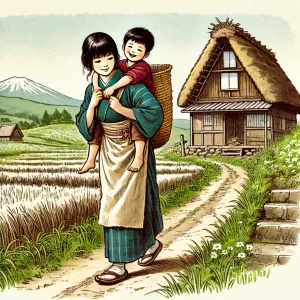赤とんぼ [Akatonbo]
Words : 三木露風 [MIKI Rofū]
Music : 山田耕作 [YAMADA Kōsaku]
“Akatonbo” is one of Japan’s most beloved children’s songs. In Japan, it falls into the categories of “dōyō” (children’s songs) and “shōka” (songs for singing).
- 赤(あか)[aka] : red
- とんぼ(とんぼ)[tonbo] : dragonfly
“Akatonbo” means red dragonfly. It is also known scientifically as “Sympetrum.” Dragonflies have been familiar insects in Japan since ancient times. Many Japanese people have memories of catching dragonflies as children. I was one of those kids too.
Nowadays, with fewer natural spaces in urban areas, children might not play like that anymore.
These lyrics were written by Rofū Miki based on his childhood memories. The lyrics were written in 1921, and the melody was composed by Kōsaku Yamada in 1927. Therefore, the song likely depicts the countryside of Japan in the 1890s.
夕焼け小焼けの 赤とんぼ
yūyake koyake no aka tonbo
- 夕焼け(ゆうやけ)[yūyake] : sunset
(translation) “Red dragonfly in the sunset.”
“夕 / yū” means evening. “焼け / yake” means burning, referring to the glowing sky. “Koyake” is a poetic expression without a special meaning.
It evokes a beautiful and vivid scene.

負われてみたのはいつの日か
owarete mita no wa itsu no hi ka
- 見る(みる)[miru] : see
- いつ(いつ)[itsu] : when
- 日(ひ)[hi] : day
(translation) “When was the day I saw it while being carried?”
“Owarete” means being carried on someone’s back, not being chased.
Although this is a children’s song written in simple Japanese, there are a few points that can be misunderstood due to the 100-year-old language.
山の畑の桑の実を
yama no hatake no kuwa no mi o
小籠に摘んだはまぼろしか
ko kago ni tsunda wa maboroshi ka
- 山(やま)[yama] : mountain
- 畑(はたけ)[hatake] : field
- 桑の実(くわのみ)[kuwa no mi] : mulberry
- かご(かご)[kago] : basket
- 摘む(つむ)[tsumu] : pick
- まぼろし(まぼろし)[maboroshi] : illusion
(translation) “Was it an illusion to pick mulberries in the mountain field and put them in a small basket?”
Mulberries are food for silkworms, essential for the sericulture industry. Around 1900, Japan was the world’s leading exporter of raw silk. Therefore, mulberry fields were everywhere in Japan. Nowadays, such landscapes are rare.
十五で姐やは嫁に行き
jūgo de neeya wa yome ni iki
- 十五(じゅうご)[jūgo] : fifteen
- 姉さん(ねえさん)[nēsan] : sister
- 嫁(よめ)[yome] : bride
- 行く(いく)[iku] : go
(translation) “At fifteen, Sister got married.”
“Neeya” is often misunderstood. It simply means an older sister but here refers to a maid.
Many farming families were very poor at that time, and children often worked as babysitters for slightly wealthier families, eventually marrying out. The one who carried the child on her back was probably this “neeya.” There might have been a slight romantic feeling towards her as well.

お里のたよりも絶えはてた
osato no tayori mo tae hateta
- 里(さと)[sato] : village
- たより(たより)[tayori] : news
- 絶える(たえる)[taeru] : cease
(translation) “News from home has stopped.”
“Sato” can mean hometown or family home, but it is unclear. In simple interpretation, it means the maid who married out stopped sending letters.
Another theory is that Miki’s parents divorced when he was five, and he was separated from his mother, who returned to her family home. They communicated through the maid, and when she married, that communication ceased, expressing the loneliness of losing contact with his mother.
夕やけ小やけの赤とんぼ
yūyake koyake no aka tonbo
とま っているよ竿の先
tomatte iru yo sao no saki
- 止まる(とまる)[tomaru] : stop
- 竿(さお)[sao] : pole
- 先(さき)[saki] : tip
(translation) “A red dragonfly at sunset is perched on the tip of a pole.”
We return to the same lyrics. The first part is childhood memories, and this part is probably the current scene after many years. The song tells a story like a movie.

This song is deeply loved by the Japanese. It has a simple melody but evokes sentimental feelings.
It’s a special song that somehow makes people nostalgic for old Japan.
Finally, let’s talk about the musical aspects of this song.
The melody of this song closely matches the pitch accent of the Japanese lyrics. This is beneficial for expressing Japanese, as a melody close to natural speech pitch makes it easier to convey emotions while singing. I think composer Yamada Kōsaku considered this.
In many old Japanese songs, melodies closely follow intonation. This song beautifully captures the sound of the Japanese language in song.
*This article is the revised 2024 blog version. The video version is below, where you can learn pitch accent.
Thanks for reading! Feel free to comment if you have any feedback or questions.
Follow me on X.



